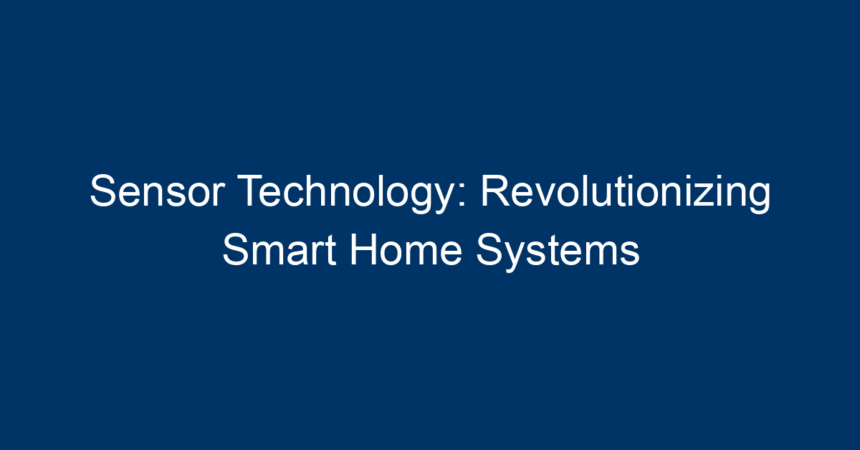In today’s fast-paced world, the integration of technology in our daily lives is no longer just desirable; it’s essential. Among the innovations revolutionizing how we live in our homes is sensor technology. From ensuring home security to enhancing energy efficiency, these advanced systems are transforming ordinary spaces into smart environments. This article delves into the realm of sensor technology in smart homes, exploring its benefits, applications, and future potential.
What is Sensor Technology?
Sensor technology refers to the use of devices that can detect and respond to various physical stimuli, such as light, temperature, motion, and sound. These sensors collect data, which is then analyzed and used to trigger actions or alerts. In the context of smart homes, sensor technology enables systems to operate autonomously or be remotely controlled.
Types of Sensors in Smart Homes
-
Motion Sensors
- Detect movement within a defined area.
- Commonly used for security systems, lighting control, and energy management.
-
Temperature Sensors
- Monitor indoor temperature and adjust heating and cooling systems accordingly.
- Help in maintaining comfort while optimizing energy use.
-
Humidity Sensors
- Measure moisture levels in the air.
- Essential for homes in humid climates to prevent mold and ensure comfort.
-
Light Sensors
- Gauge natural light levels to adjust artificial lighting.
- Enhance energy efficiency and create perfect ambiance.
-
Smoke and Carbon Monoxide Detectors
- Alert residents of smoke or CO presence, ensuring safety.
- Modern versions often have smart features that send alerts to smartphones.
- Window and Door Sensors
- Detect whether windows and doors are open or closed.
- Primarily used in security systems to ensure peace of mind.
Benefits of Sensor Technology in Smart Homes
The impact of sensor technology on smart homes is profound, providing numerous advantages to homeowners. Here are some key benefits:
Enhanced Security
One of the primary concerns for homeowners is security. Sensor technology significantly enhances home security through motion detectors, window sensors, and cameras. When a sensor detects unusual activity, it can trigger alarms and send notifications to homeowners’ smartphones, allowing for real-time monitoring and response.
Energy Efficiency
Energy conservation is a growing concern amidst rising utility costs and environmental issues. Smart homes equipped with sensor technology can optimize energy usage. For example, temperature sensors can adjust the thermostat based on occupancy, while light sensors can ensure that lights are only on when needed. This not only reduces energy bills but also lessens the carbon footprint.
Convenience and Automation
Sensor technology enhances convenience by automating routine tasks. Lights can turn on automatically when someone enters a room, and thermostats can adjust based on the time of day or occupancy. This level of automation simplifies life, allowing homeowners to focus on what truly matters.
Improved Home Comfort
With the ability to monitor various environmental aspects, sensor technology contributes to a more comfortable living space. Temperature and humidity sensors can work together to maintain optimal indoor conditions, making homes feel more pleasant year-round.
Real-World Applications of Sensor Technology in Smart Homes
The versatility of sensor technology is evident in its diverse applications within smart home systems. Here are some examples:
Smart Thermostats
Smart thermostats utilize temperature and humidity sensors to learn user preferences and adjust settings automatically. This not only ensures optimal comfort but also maximizes energy efficiency, leading to significant savings.
Smart Lighting Systems
Smart lighting systems employ light sensors to adjust brightness levels based on natural light availability and user presence. Automated lighting can enhance safety and aesthetic appeal while reducing energy waste.
Home Security Systems
Many home security systems rely heavily on sensor technology. Motion detectors and window sensors create a comprehensive security network that can be monitored remotely for enhanced peace of mind.
Smart Home Assistants
Voice-activated assistants like Amazon Alexa or Google Assistant come equipped with various sensors that enable them to interact with users effectively. From controlling smart devices to providing information on demand, these assistants symbolize the seamless integration of sensor technology.
Smart Appliances
Modern appliances are becoming increasingly smarter, with sensors that enable them to function more efficiently. For example, refrigerators equipped with temperature sensors can maintain optimal conditions for food preservation, while washing machines can adjust cycles based on load size.
Challenges and Considerations
Despite the benefits, the integration of sensor technology in smart homes does come with challenges. Here are some key considerations:
Privacy and Security Concerns
With increased connectivity comes the risk of data breaches. Homeowners must be vigilant about the security of their devices and networks to prevent unauthorized access.
Compatibility Issues
Not all smart devices communicate seamlessly with one another. Homeowners may encounter compatibility issues when integrating devices from different manufacturers. Researching interoperability is crucial before investing in smart home technology.
Initial Costs
While sensor technology can lead to long-term savings, the initial investment can be significant. Homeowners should weigh the upfront costs against potential savings over time.
The Future of Sensor Technology in Smart Homes
The future of sensor technology in smart homes looks promising. As technology advances, we can expect the following trends:
Increased Integration with AI
Artificial intelligence will play a pivotal role in making smart homes even smarter. With AI algorithms, sensors will learn and adapt to user behaviors, creating even more personalized experiences.
Enhanced Energy Management
Energy management systems will become more sophisticated, allowing for real-time monitoring and optimization. This technology will enable homeowners to track their energy usage and receive suggestions for improvement.
Greater Focus on Sustainability
As awareness grows about environmental issues, sensor technology will focus more on sustainability. Homes will incorporate eco-friendly sensors and systems that prioritize energy conservation.
Expanding Applications
The applications of sensor technology will extend beyond traditional uses. Innovations in healthcare, such as remote patient monitoring, and advancements in home automation will open new avenues for sensor deployment.
Conclusion: Embrace the Revolution
Sensor technology is not just a trend; it’s a revolution in how we approach home automation and security. By understanding and embracing these innovations, homeowners can significantly enhance their quality of life. Investing in smart home systems that harness sensor technology can lead to improved security, energy efficiency, convenience, and comfort.
To make the most of this revolution, consider starting small: integrate a few smart devices into your home, evaluate their impact, and gradually expand your system. As technology continues to evolve, the possibilities for your smart home are limitless. The time to embrace sensor technology is now—transform your living space into a haven of efficiency and comfort today.




